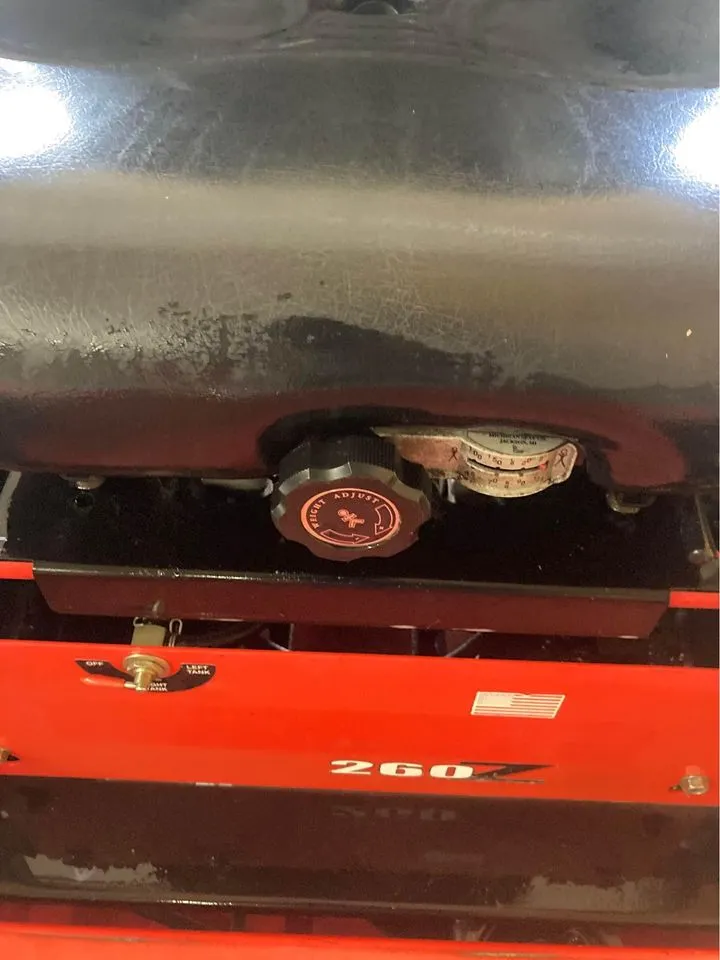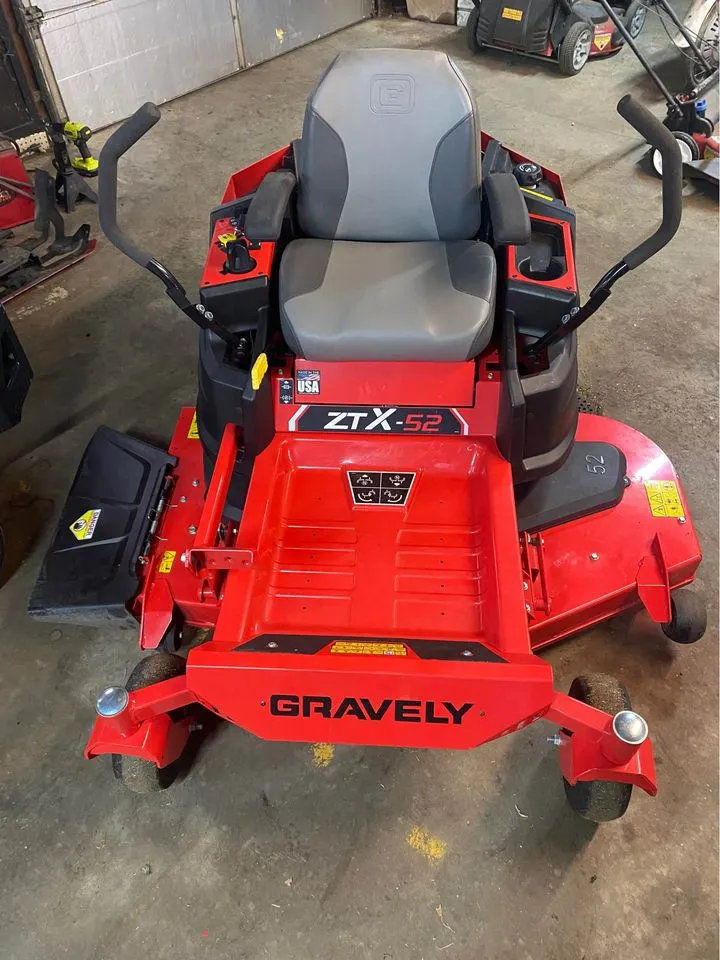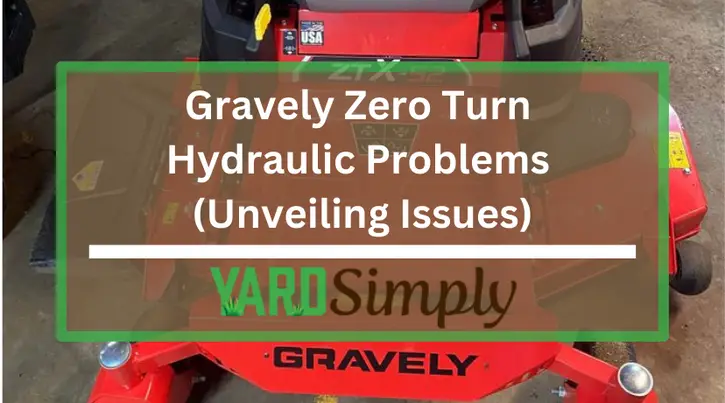Every Gravely zero turn mower owner knows that a day without hydraulic issues is like a summer without sun—practically unheard of.
As someone who’s spent years navigating the labyrinth of mechanical woes that these machines can present, I’ve come to view their hydraulic systems as both a marvel of engineering and a source of relentless frustration.
Whether it’s the ominous whine of a stressed pump, the mysterious cavitation that seems to plague the system at the worst possible times, or the erratic behavior that leaves me scratching my head, I’ve tackled them all.
And just when I think I’ve got a handle on it, a new symptom arises, challenging my knowledge and patience.
Quick Summary
- Identifying specific hydraulic problems like pump noise or cavitation in Gravely zero turn mowers requires careful observation of mower performance and sounds, along with regular maintenance checks.
- Addressing Gravely zero turn mower hydraulic issues involves regular system checks, particularly for pump noise, cavitation, overheating, low pressure, and erratic operation.
- Proper hydraulic maintenance can extend the life of zero turn mowers by up to 50%, highlighting the importance of routine upkeep.
- In my experience, consistent attention to the hydraulic system is crucial for ensuring the longevity and optimal performance of Gravely Zero Turn mowers.
Hydraulic Issues in Gravely Zero Turn Mowers
Managing a Gravely zero turn mower requires an understanding of its hydraulic system, which is essential for smooth operation. Despite their advanced design, these systems can face several issues.
Here’s a brief list of common hydraulic problems encountered with these mowers, helping owners quickly identify and address potential challenges.
- Hydraulic Issues
- Noise in the Hydraulic Pump
- Cavitation in Pump
- Overheating of System
- Low System Pressure
- Erratic Operation of System
Related Articles:
- Husqvarna Zero Turn Mower Hydrostatic Drive Problems
- Cub Cadet Zero Turn Hydrostatic Problems
- Gravely Zero Turn Mower Problems
Noise in the Hydraulic Pump of Gravely Zero Turn Mower
- Listen for Unusual Sounds: Start the mower and listen to the hydraulic pump. The pump should normally operate with a consistent, low humming sound. Any deviation, like whining, grinding, or excessive humming, can indicate a problem.
- Identify the Type of Noise: Different sounds suggest different issues. A whining sound might imply issues with fluid levels or aeration, while grinding could signal internal wear.
Solution for Noisy Hydraulic Pump
- Check Hydraulic Fluid Level and Quality:
- Verify if the fluid level is low or if the fluid is contaminated.
- Top off or replace the hydraulic fluid to reduce strain on the pump.
- Inspect the Hydrostatic Drive System:
- Look for any malfunctions that could be putting extra strain on the pump.
- Check pump pressure and relief valve function:
- Ensure the pump pressure is correct.
- Verify if the relief valve is functioning properly and not stuck.
- Adjust as needed, as these are key in regulating hydraulic system pressure.
- Adjust or Repair Components:
- Make necessary adjustments or repairs to the above components to solve the issue.
- Aim to restore smooth and quiet operation of the mower.
Cavitation in Gravely Zero Turn Mower Pump
To identify the issue of cavitation in the hydraulic pump of a Gravely zero turn mower, it’s important to first understand what cavitation is and then recognize its specific signs.
Cavitation in hydraulic pumps occurs when the hydraulic fluid’s pressure drops below its vapor pressure, leading to the formation of vapor bubbles within the fluid.
When these bubbles collapse, they create shock waves that can damage the pump’s internal components.
Here’s how to identify this issue:
- Performance Decline: The first sign of cavitation is often a noticeable drop in the mower’s performance. This might manifest as reduced efficiency in the hydraulic system, leading to weaker or less responsive mower operations.
- Characteristic Noise: Cavitation typically produces a distinctive noise that sounds like gravel or marbles moving through the pump. This noise is created by the implosion of vapor bubbles within the hydraulic fluid.
- Vibration: Along with the noise, cavitation can also cause unusual vibrations in the hydraulic pump. These vibrations are due to the rapid collapse of the vapor bubbles and the resulting shock waves.
Solution for Pump Cavitation
- Check Hydraulic Fluid Level and Quality:
- Routinely inspect the hydraulic fluid level in the mower.
- Ensure the fluid is at the correct level; if it’s low, top it up.
- Inspect for Contamination:
- Examine the hydraulic oil for signs of contamination.
- Look for any dirt or debris in the oil that might introduce air into the system.
- Regular Maintenance of Hydraulic Fluid and Filters:
- Change the hydraulic fluid and filters regularly.
- This maintenance helps prevent cavitation by keeping the fluid clean and free of contaminants.
- Monitor for Signs of Cavitation:
- If you suspect cavitation, assess the mower’s performance and listen for any unusual noises from the pump.
- Inspect the Hydraulic Pump and Components:
- Check the hydraulic pump and its components for signs of wear or damage.
- Look for any indications that might suggest the pump is the source of cavitation.
- Repair or Replace as Necessary:
- If you find any damage or wear that could be causing cavitation, be prepared to repair or replace the affected components.
Overheating of Gravely Zero Turn Mower System

Identifying the issue of overheating in the hydraulic system of a Gravely zero turn mower involves understanding the signs and conditions that typically point to this problem.
Overheating in such systems can stem from various causes and can lead to significant damage if not promptly addressed.
Here are the key steps to identify overheating in the hydraulic system:
- Monitor Operating Temperature: During use, keep an eye on the mower’s operating temperature. The hydraulic system should not become excessively hot to the touch after only a short period of use. Excessive heat generation is a primary indicator of overheating.
- Observe Performance Changes: Pay attention to any performance changes in the mower while operating. Overheating can cause the mower to operate less efficiently, potentially manifesting as reduced power or sluggish hydraulic response.
- Check for Unusual Smells: Be alert to any unusual smells, like burning or excessively hot oil, emanating from the hydraulic system. These odors can indicate overheating of hydraulic fluid or components.
- Inspect for Hydraulic Fluid Discoloration: Regularly check the color of the hydraulic fluid. Overheating can cause the fluid to darken or appear burnt, indicating degradation due to high temperatures.
Solution for System Overheating
- Inspect Hydraulic Fluid Levels and Condition:
- Check the level of the hydraulic fluid. If it’s low, top it off.
- Examine the condition of the fluid. If it appears dirty or contaminated, replace it with the correct type.
- Check Cooling Fins and System’s Fan:
- Inspect the cooling fins and the fan of the hydraulic system.
- Look for any debris that might be blocking airflow.
- Clear out any obstructions to ensure optimal airflow and cooling.
- Assess for Potential Leaks or Damage:
- If overheating continues, inspect the hydraulic system for leaks.
- Check for any damaged components that might be affecting the system’s efficiency.
- Regular Maintenance:
- Maintain a routine of regular checks and maintenance.
- This preventive approach is crucial for avoiding overheating issues and ensuring smooth operation of your mower.
Low System Pressure
To identify the issue of low system pressure in a Gravely zero turn mower, it’s important to understand the signs and symptoms that typically indicate this problem.
Low system pressure in the hydraulic system can significantly affect the mower’s performance and efficiency.
Here are the steps to identify this issue:
- Observe Mower Performance: A noticeable decline in the mower’s performance is often the first sign of low system pressure. This might manifest as reduced responsiveness or power in the hydraulic functions, such as steering or lifting mechanisms.
- Check Hydraulic Fluid Levels: Inspect the level of hydraulic fluid in the system. Low fluid levels are a common cause of reduced hydraulic pressure, leading to poor system performance.
- Inspect Fluid Condition: Along with the fluid level, check the condition of the hydraulic fluid. Contaminated or old fluid can impair the system’s ability to maintain pressure.
- Listen for Unusual Noises: Pay attention to any abnormal noises coming from the hydraulic system, such as whining or groaning sounds, which can indicate low pressure.
- Monitor Hydraulic Functions: Test the various hydraulic functions of the mower. Difficulty in performing tasks that require hydraulic power, like raising or lowering attachments, can be a sign of low pressure.
Solution for Low System Pressure
- Check for Signs of Hydraulic Leaks:
- Begin by inspecting the hydraulic system for any signs of leaks.
- Look for wet spots, drips, or seepage along the hydraulic lines, fittings, and components.
- Confirm No Leaks Present:
- Ensure that there are no leaks in the system.
- Leaks can lead to a drop in hydraulic pressure and should be addressed before proceeding.
- Inspect the Relief Valve:
- Locate the hydraulic system’s relief valve.
- Check if the valve is set correctly, as per the manufacturer’s specifications.
- Adjust the Relief Valve:
- Carefully adjust the relief valve to ensure it is set to the correct pressure setting.
- This adjustment is crucial for maintaining optimal hydraulic power and system efficiency.
- Test for Proper Pressure:
- Once adjustments are made, test the hydraulic system.
- Observe if the maneuverability and efficiency of the mower have improved.
- Monitor for Vibration and Performance:
- After the adjustment, keep an eye out for any unusual vibrations or performance issues.
- Improperly set relief valves can cause vibrations and potentially lead to damage.
- Recheck if Issue Persists:
- If the problem continues, re-examine the relief valve and hydraulic system.
- Additional adjustments or a more thorough inspection may be required.
Erratic Operation of Gravely Zero Turn Mower System

Identifying the issue of erratic operation in a Gravely zero turn mower system requires careful observation and understanding of the symptoms that characterize this problem.
Erratic operation can manifest in various ways and is often a sign of underlying issues in the mower’s mechanical or hydraulic systems.
Here’s how to identify this issue:
- Observe Movement and Handling: Notice if the mower is not moving smoothly. Erratic operation can present as jerking motions, difficulty in maintaining a straight line, or sudden changes in speed.
- Check for Inconsistent Speeds: Pay attention to the mower’s speed. If it’s varying unpredictably or not responding correctly to your input on the controls, this could be a sign of erratic operation.
- Listen for Unusual Noises: Be aware of any strange noises coming from the mower during operation. Sounds like grinding, whining, or clunking can accompany erratic movement.
- Feel for Unexpected Vibrations: Hold the controls and feel for any unusual vibrations. Erratic hydraulic or mechanical function can cause the mower to vibrate more than usual.
- Monitor Response to Controls: Test how the mower responds to your steering and speed controls. Erratic operation can manifest as a delay in response or over-responsiveness.
Solution for Erratic System Operation
- Check Hydraulic Fluid Level:
- Inspect the hydraulic fluid level in the system.
- Ensure it’s at the recommended mark according to the manufacturer’s guidelines.
- If the fluid level is low, top it off with the appropriate hydraulic fluid.
- Observe Performance Changes:
- After adjusting the fluid level, monitor the mower for any changes in performance.
- Check if the erratic operation has improved or persists.
- Inspect the Dampers:
- Examine the dampers, which are essential for smooth mower operation.
- Look for signs of wear or damage to the dampers.
- Replace Worn or Damaged Dampers:
- If the dampers are found to be worn or damaged, replace them with new ones.
- Ensure the new dampers are compatible with your mower model.
- Inspect the Belt for Wear or Improper Tension:
- Check the mower’s belt for any signs of wear, damage, or improper tension.
- Look for cracks, fraying, or looseness in the belt.
- Adjust or Replace the Belt:
- If the belt is loose, adjust it to the correct tension as specified by the manufacturer.
- If it is damaged or excessively worn, replace the belt with a new one.
Our Verdict
In my experience with Gravely zero turn hydraulic problems, I’ve come to realize the crucial role of diligent maintenance.
Tackling each challenge, from the tell-tale noises of a struggling pump to the complexities of cavitation and overheating, has taught me invaluable lessons.
Keeping a vigilant eye on system pressure and addressing erratic operations promptly has been pivotal in ensuring my mower’s smooth performance.
Regular checks and maintenance have not just prevented these hydraulic issues but have also significantly extended my mower’s lifespan.
My verdict is clear: consistent and careful upkeep is indispensable for any Gravely zero turn mower owner who seeks to maintain their machine’s longevity and peak performance.
Frequently Asked Questions
Can using aftermarket hydraulic fluid as opposed to the brand recommended by Gravely affect the performance of my zero turn mower?
I’ve found that using aftermarket hydraulic fluid instead of the recommended brand can sometimes affect my mower’s performance, potentially causing issues with responsiveness or even leading to longer-term damage.
Are there any specific weather or temperature conditions that exacerbate hydraulic problems in Gravely zero turn mowers?
I’ve noticed that cold weather often makes my mower’s hydraulics sluggish. Extreme heat can also cause issues, leading to overheating or fluid degradation, which in turn affects my mower’s performance.
How often should I have a professional service check on the hydraulic system of my Gravely zero turn mower to prevent long-term issues?
I should get a pro to check my mower’s hydraulics annually, but if I’m using it heavily, I’ll do it twice a year to avoid any long-term issues.
What are the environmental implications of a hydraulic fluid leak from my Gravely zero turn mower, and how can i minimize its impact?
I’m concerned about the environmental impact of a hydraulic fluid leak. To minimize harm, I’ll fix leaks promptly and properly dispose of the fluid, reducing soil and water contamination risks.
Can modifications or attachments to my Gravely zero turn mower lead to increased strain on the hydraulic system, and how can i mitigate that?
Yes, adding modifications or attachments to my mower can strain the hydraulics. I’ll ensure they’re compatible and regularly check the system to prevent issues. Preventive maintenance is key to mitigating potential problems.


